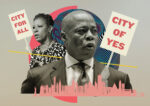During the first year of his administration, Mayor Eric Adams was notably coy about housing projections.
At the time, he said he did not want to set housing goals in terms of numbers.
But by the end of the year, he changed his mind, and announced a “moonshot goal” of building 500,000 units over the next decade.
Then, just a month later, as part of his State of the City address on Thursday, the mayor announced yet another number: 100,000 units to be added to Manhattan over the next decade, dubbed the Manhattan Plan.
“The housing crisis is real, and we know how to solve it: By building more homes,” the mayor said.
The details on how that will happen are fuzzy, as are what previously announced initiatives are included in the Manhattan Plan’s count.
In a press release, the administration indicated that it will review all zoning in Manhattan to “unlock potential housing sites for development from Inwood to the Financial District.”
Presumably, the city will look at opportunities to upzone parts of Manhattan, as it plans to do in Midtown South. Recent changes made in the state budget and the City of Yes for Housing Opportunity allow for higher residential density — buildings 15 or 18 times larger than their lot size — if sites or, in the case of Midtown South, neighborhoods are rezoned.
“Manhattan is the densest borough,” said Sheila Pozon, a partner at Kramer Levin. “There’s a lot of opportunities to explore where those rezonings make sense.”
The mayor’s new goal underscores the difficulty in disentangling housing unit projections, in deciphering which initiative gets credit for which new home created and whether units are being counted more than once. That becomes more difficult when timelines include multiple mayoral administrations, and when a new number is announced without many details on how the goal will be achieved.
Based on what has been announced and what representatives for the administration can confirm, 12,500 units can be accounted for at this time, though more are expected as part of City of Yes and housing planned for public sites.
Baked into the 100,000 figure are an unknown portion of the 80,000 units that the administration believes will be created citywide over the next 15 years, thanks to the City of Yes’ zoning changes. It also includes the 9,700 units that the administration estimates will be created by rezoning Midtown South.
Those projections, of course, rely on developers taking advantage of those zoning changes. Developers may not build as much housing as they can, because higher wage requirements kick in for larger 485x projects.
The count also includes 2,000 units that will be created at 100 Gold Street, an office building where the Department of Housing Preservation and Development is headquartered, and which may be demolished to make way for more residential housing.
HPD and the other city agencies in the building will then be on the hunt for new office space. The Department of Citywide Administrative Services will use the proceeds from the redevelopment towards new office space for the agencies. A senior center in the building will also need to be relocated.
On Thursday, the mayor touted surpassing his administration’s goal of advancing 24 housing projects on public land in 2024, by moving 26 forward last year.
“Advance” here represents different degrees of progress — issuing a request for proposals and initiating community engagement, for instance, count in the mayor’s tally. Of those projects, roughly 5,000 are expected to be built or preserved in Manhattan, though it is not clear if all of the new units expected from these projects — around 2,000 —are included in the Manhattan Plan.
The Manhattan Plan’s projection also includes 800 units that are planned as part of a project that will also create a new facility for the Bloomingdale Library in Manhattan Valley on the Upper West Side.
Administration officials could not provide a list of projects included in the Manhattan Plan’s estimates.
State of the city addresses are an opportunity for mayors to brag and, often, soft-launch policy priorities in the days leading up to the speech. This year’s edition comes as Adams faces criminal charges and an increasingly competitive primary in June.
Last month, one of his opponents, Sen. Zellnor Myrie, pitched a housing plan that called for creating or preserving 1 million homes over the next 10 years. That proposal also focused on opportunities to upzone more of Manhattan. It too included projects that have already been proposed and lacked specifics on execution, though it did provide unit estimates that could result from each component of the plan and acknowledged that 200,000 of the apartments would result from organic growth.
Outside Manhattan, the administration wants to initiate housing projects at city-owned sites at 395 Flatbush in Downtown Brooklyn, on the waterfront in Coney Island and in St. George on Staten Island.
During Thursday’s address, the mayor announced City of Yes for Families, which will seek to build more family-sized housing units and make it easier to build housing near schools, accessible transit, libraries, grocery stores and playgrounds.
Other details on what the proposal would entail, other than that the Manhattan Plan is part of it, were sparse.
Read more



Adams announced a number of funding commitments, including a $650 million investment to address street homelessness, which includes adding 900 beds in Safe Haven shelters and opening a new facility to help unsheltered New Yorkers dealing with mental illness. He also reiterated his call on Albany to pass a bill that would eliminate or cut city income taxes for New Yorkers earning less than a certain amount.
He did not, however, address the possibility of funding cuts at the federal level as Republicans take control of the White House and Congress, which will loom large over state and city budget talks.
